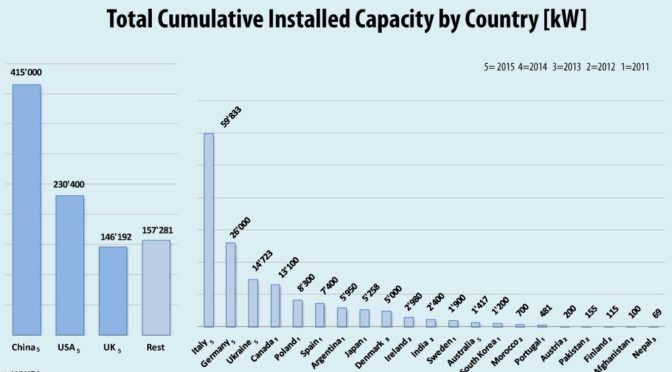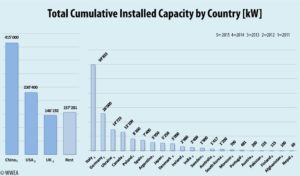On the occasion of the World Small Wind Conference held during Intersolar Europe in Munich (Germany), WWEA has released the global small wind statistics. The Summary of the 2017 Small Wind World Report indicates that 2015 was one of the most challenging years for the small wind industry in the recent years.
As of the end of 2015, a cumulative total of at least 990’000 small wind turbines were installed all over the world. This is an increase of 5 % (8,3 % in 2014) compared with the previous year, when 945’000 units were registered. It means that worldwide, several million families are getting power from small wind turbines. However, only in Italy, the number of new installations increased during 2015.
The recorded small wind capacity installed worldwide has reached more than 945 MW as of the end of 2015. This is a growth of 14 % compared with 2014, when 830 MW were registered. In 2012, 678 MW were installed. China accounts for 43 % of the global capacity, the USA for 25 %, UK for 15 % and Italy for 6,3%.
A downward trend in supporting policies for small wind in the three biggest markets has decreased the number of new installations although the installed capacity was bigger than in the previous year. Smaller markets like Italy or Japan, with more favorable policies, have attracted the industry and became a lifesaver for the sector. Markets like Japan or Australia will become more and more important for small wind manufacturers in the next years.
China continues to be clearly the market leader in terms of installed units: at least 43’000 units were added in 2015, reaching 732’000 units installed by the end of 2015 and accounting for 93 % of the new units installed worldwide.
Stefan Gsänger, WWEA Secretary General: “Small wind can contribute substantially to the power supply in many countries of the world. In particular in hybrid systems and in combination with solar and other renewable technologies, small wind turbines can enable citizens, communities and businesses to produce power at affordable cost, without harming the environment. However, the manufacturing sector requires policies which provide predictable and sizable markets in order to invest and scale up production facilities. If this is given, prices for small wind turbines will decrease further. The small wind sector itself will continue working on improving quality of its products by aiming at harmonizing and simplifying international standards and certification schemes.”
The full Small Wind World Report Update 2017 can also be downloaded as PDF


